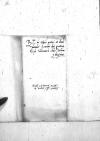Reverendissime in Christo Pater et Domine, domine colendissime.
Officiosissimam servitutis meae commendationem.
Simul ut ⌊Psitacus⌋ huc advolavit, ⌊regia maiestas⌋ ex catharro coepit laborare . Quae causa fuit, quod in hunc usque diem Reverendissimae Dominationis Vestrae litterae et ⌊dominorum consiliariorum⌋ lectae non sunt. Neque enim ad ⌊maiestatem eius⌋ aditus patebat, quam non esse putabant negotiis ullis occupandam in hac sua non firma valetudine. Itaque heri primum habita est apud ⌊maiestatem eius⌋ de absolvendo Turcico legato consultatio, cui intererat ⌊maiestas reginalis⌋, neque erat tempus opportunum litteras legendi. Dabo tamen operam, ut legantur primo quoque tempore.
⌊Vicinus⌋ Reverendissimae Dominationis Vestrae functus est apud ⌊maiestatem regiam⌋ legatione nomine protestantium, ut si quid in concilio durius contra illos decretum esset ac ad societatem armorum regia maiestas invitaretur a catholicis, ne sibi persuaderi pateretur, ut arma contra eos sumeret. Et habuit litteras fidei a duce Saxoniae et Lantgravio. Ceterum non exposuit suam legationem nisi coram ⌊regia raiestate iuniore⌋, atque eius intercessione usus missis fidei litteris ⌊regiae maiestati seniori⌋ legationem scriptam misit. Simul etiam usus est intercessione serenissimi ⌊filii⌋ ad ⌊paternam maiestatem⌋ de moneta non exterminanda, de nuntio mittendo ad comitia imperii in proscriptionis negotio, et ut illustri domino Alberto marchioni Brandeburgensi iuniori regia maiestas inhiberet, ne se coram iudicio camerae sisteret aut saltem non susciperet iudicium, ad quod vocatus est, quod feudum acceperit ⌊Ducatus Prussiae⌋. Quod tamen a ⌊maiestate regia⌋ concessum ei esse nondum constat: hae videntur causae fuisse profectionis eius ad ⌊regiam iuniorem⌋. Aliae aliquae an fuerint, nos nescimus. Sed nondum responsum tulit, cum prope viginti dies hic sit commoratus.
Deum precor, ut Reverendissimam Dominationem Vestram diu servet incolumem.
Cuius me gratiae commendo.

